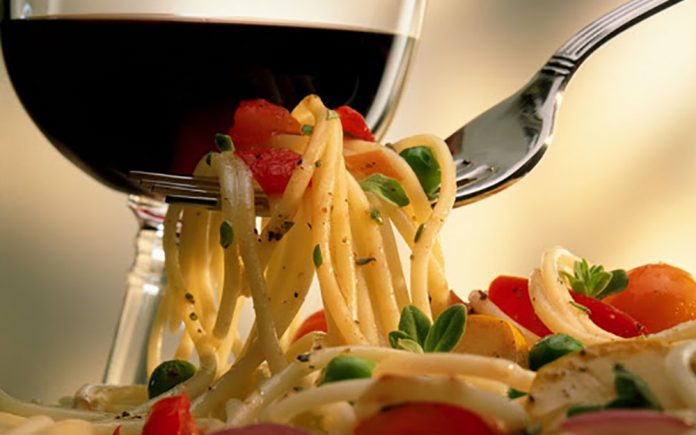
By Rick Riozza
On the days when we’re not helping our business community by ordering take-out, many in the household are in the kitchen with Dinah trying out some tried & true recipes and experimenting with new ones. It’s been said that when you cook, you’re drawn to the things that have a place in your heart, and home is where the heart is.
So what are your top five favorite foods —as if you could only eat from these five categories for the next five years (God willing of course!). Or—if it’s not too soon, what major food staples could you be happy with, staying home, for the next three four months?
Well—mine, and perhaps yours, would be: meat, cheese & dairy, potatoes, bread & pasta, salads, and of course wine for a beverage. How do you like that grouping? And how do you like the way I count?
Okay—all right, and then there’s tacos. There are a lot of great tasting tacos out there with many variations on a theme. One could probably eat a different type of taco every day of the year. And because we can utilize all the must-have food categories in the preparations, tacos (and maybe even burritos) get to stay in our food club as a matter of right!
But Momma Mia! This article will focus itself on one of the best culinary pairings in the gastronomic heights: Pasta & Wine Pairings. It can be as simple as matching pasta Bolonese with a decent bottle of Chianti, or, a Tuscan wild boar ragú with pappardelle and a Vino Nobile di Montipulciano. As a duty to the readership stuck at home, we decided to do the right thing and experiment with different pasta dishes and different wines, and this is our report.
Pairing wine and pasta is more of an art than science. It’s all about balancing the flavors of the dish with the flavors in the wine. Pasta, as we all know, tastes like anything that one makes it to taste—via spices, herbs, sauces, cheeses; you name it—make it yours! Popular sauces are traditionally added to pasta, such as red, tomato-based sauce, creamy-white sauce, pesto sauce, etc.
Our tasting panel consisted of myself, representing the CV Weekly; Paolo Max and Penny Ione from the Palm Springs Wine Blog; and Desert Arc’s Guy Laurent/Guido Lorenzo—that French-Italian over-eater who can consume a dish in seconds flat! Further, we all brought together some wine we already had on hand on our shelves and refrigerators—so avoiding unnecessary travel. And we’re using wine to dictate the pasta preparation.
So whether you have a Barbera d’Asti or Barbera d’Alba or even a good Lodi Barbera, the wine’s high-acid character and its alluring display of red fruits can stand up well to the array of pasta dishes that goes big on the tomato sauce, a Bolognese for example. We also found that this same Barbera is the bomb with a beef lasagne where the acidity helps to balance the cream béchamel sauce. You’d think that a bold red would work, but when we tried a big oaky Cabernet Sauvignon the dish showed some bitter notes.
We know plenty of folks who serve a Chardonnay with their gloriously comforting macaroni cheese dish; but don’t be scared! A Barbera can cut through the richness and provides a nice tasty fruit relief—which means, one can probably enjoy another helping or two of the pasta, and, another glass of wine while we’re at it.
Experienced red wine lovers have always found a likable link between the Italian Barbera and the French Beaujolais as to feel, flavor, acidity in a lighter body. Thus, have at it with a Villages or Cru Beaujolais and Bolognese or beef lasagne.
And I’ll even out on a lasagne limb and offer that an Austrian Zwiegelt would be a fine substitute for Barbera or Beaujolais as well. If you don’t believe me, go ask Austrian- born Chef Johannes Bacher, owner and executive chef of his eponymous Palm Springs Restaurant (currently doing take-out) and I think he’ll agree with me on the under-the-radar red wine from Austria.
We all know Piemonte’s two wine gifts to the world, Nebbiolo’s Barolo and Barbaresco, where a vintage Nebbiolo simply takes your truffle pasta dish and herbs to the heavens. If you’re short on truffles, try a wild mushroom concoction with herbs, a dash of cream in the sauce served with egg-rich, but thin, tagliatelle. The Nebbiolo will provide cherries, mushrooms, violets, wild herbs, and a touch of tar and tobacco—don’t wince, that dish is delish!
That brings us to Sangiovese, which in its various guises can offer vibrant red fruit, sanguine and iron notes, herbs and a touch of spice, depending on the style. Its heartland is Tuscany, of course, with Chianti Classico being the most popular wine for the area.
Chianti is pretty versatile on the dinner table, but watch out for younger wines with too much tannin or structure, because they might overpower your dish. And speaking thereof, always throw in a good splash or three, into your tomato-based sauce when cooking.
For those who have a fancy wine collection, you’ll want to display your Brunello di Montacino with your pasta. Remember though, the much less expensive younger cousin, Rosso di Montalcino, works great with spaghetti and pork or beef meatballs, particularly if the meat is infused with herbs and a bit of black pepper.
Sausage and fennel, perhaps with fusilli, is another classic that often works well with Sangiovese’s red fruit and wild herb character. Cabernet Franc could also be a great partner here.
Now that we’re on a roll, we’ve run out of space. Since no one’s going anywhere—quite literally. We’ll continue this story later. Buon Appetito! Saluti!










































